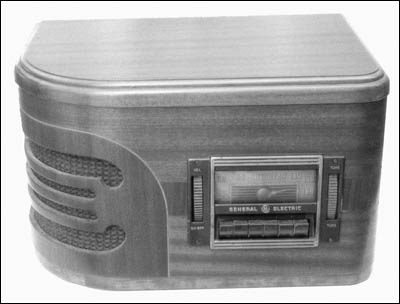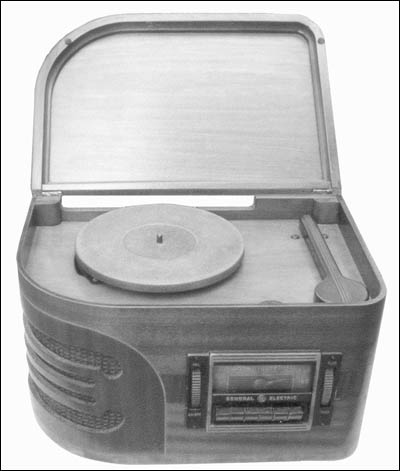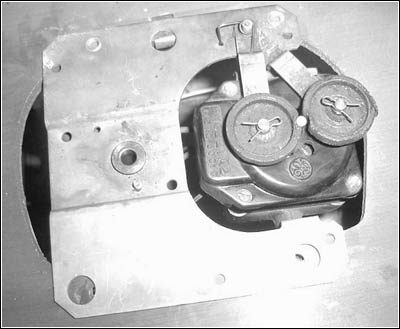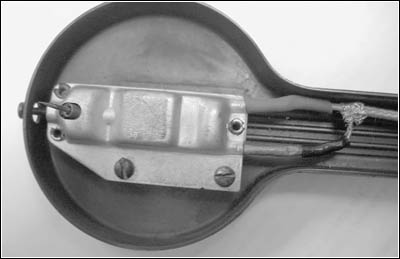Of Old Radios And Related Items--Published Monthly
General Electric Model HJ-618-AC
Radio/Phonograph CombinationBY NEIL F. ROBAR and DANNY SCHAFER
Web Edition
One article frequently leads to another, and that's a very good thing for us collectors. Both Neil Robar and Danny Schafer were inspired by Richard Arnold's February 2006 article on the GE "Feather-Touch" Model HJ-624-AC radio only. Their Models HJ-618 look almost identical to Richard's Model HJ-624, but opening the lid of the HJ-618-AC reveals a compact 78 rpm phonograph, in addition to the standard broadcast radio.
Neil sent in photos of his restored set and added a few words of description.
Danny describes his restoration of the radio and the phonograph mechanism for this prewar GE radio. (Editor)
Figure 1. Neil Robar's GE Model HJ-618-AC bears a strong resemblance to the Model-624. The HJ-618-AC's cabinet is slightly taller and the scroll work on the speaker end of the cabinet is a bit fancier.GE Model HJ-618-AC
BY Neil F. RobarThe February 2006 issue of A.R.C. featured a short article on the General Electric Model HJ-624. This 1939-1940 radio was also produced as Model HJ-618-AC. Figures 1 and 2 (see print version) show the two models. Though almost identical to the HJ-624 in outward design, the Model HJ-618-AC also included a small phonograph under a hinged top lid, as shown in Figure 3. In the phono arm is a switch that turns the phono on or off when the arm is raised or lowered.
I agree with Richard Arnold that the model he restored, as well as my restored model, are "good lookers." I too get a lot of positive comments when the set is shown.
Figure 3. Neil Robar's GE Model HJ-618-AC with its lid open revealing the 78 rpm turntable and tone arm.(Neil F. Robar, 811 Second St., Neptune Beach, FL 32266)
Neil Robar has been interested in radio since the 1940s when his father gave him and his brother an old Howard to play with. They got it working and listened to stations all over the country. Serious collecting began 20 years ago, and his pride and joy is a 1933 Majestic Model 344 lowboy, now fully restored and working. He is a member of the Jacksonville, Florida, Antique Radio Society.
G.E. Model HJ-618-AC
BY DANNY SCHAFERA client from my "real" job asked me to restore his aunt's old record player, which is the General Electric Model HJ-618-AC radio-phonograph, shown in Figure 4 (see print version). The unit appeared to have been stored in an attic for many long years.
What I found interesting about this set is the opening at the back of the unit to accommodate the diameter of a 10" record disc. When a record is placed on the platter, a small portion of it sticks out of the rear. The phonograph can be played with the lid down, completely hiding the phonograph operation.
Just as interesting is the large lollypop looking tonearm, which is additionally a 3-position function switch. When the radio is playing, the rear of the tonearm is stowed in the pushed-down position; pulling up on the rear of the tone arm switches the audio input from radio to phonograph. Swinging the tonearm toward the spindle switches on the phono motor. Therefore, to operate the phonograph, you must pull the tonearm up and swing it toward the edge of the record. Luckily, the switch contacts were in good condition when I acquired this set, and Rider has a great illustration of the assembly.
This radio/phono design is an inexpensive unit, circa 1939/40, but of decent quality. Certainly the designers of this set did not expect or even want it to survive and properly operate into the 21st century. However, here's one that made it and is surviving well.
Figure 5. Obvious in this photograph is the need for rebuilding the deteriorating idler wheels, typical of those found in old phonographs.The Radio Restoration
Evaluating the radio, I found that the line cord insulation crumbled off when moved and flexed, and the dual idler wheels were totally dry rotted and sort of form melted around the motor capstan, shown in Figure 5.
I did not even bring the thing up on a Variac. I just went ahead with the recapping, tube testing, alignment and replacement of the chassis wiring that had crumbling insulation. In general, the radio restoration was easy with no difficult surprises.
The Phonograph Restoration
This was my very first phono restoration, which I started in April 2004. It took me until late summer to finish it completely. I did nothing to the cabinet. But, with my slight apprehension about and inexperience with phonographs, and having no way to make new idler wheels, let alone rebuild the cartridge, I farmed the job out to an expert -- Gib at West-Tech, Smithville, West Virginia. The phonograph was not a unit from my own collection, and I wanted to return it in good working order to my client.
Figure 6. A view of the rebuilt phonograph cartridge mounted in the pick-up arm.The on/off/volume switch was stuck in the on position, and I could not get a signal out of the cartridge; even the #44 pilot lamp was burned out. I sent the motor assembly, volume switch and cartridge to Gib, who was able to correct all these problems expertly. I give my biggest thanks to Gib. He provided new idler tires, cleaned and lubed the motor, rebuilt the cartridge, fixed the power switch, and even replaced the leads in the tonearm -- all at very reasonable cost. Figure 6 shows the rebuilt phono cartridge.
After I had reinstalled the motor with its nice new rubber wheels, the motor played too slowly. After reexamination and some head scratching, a good friend and I heard a very slight dragging sound (he has good ears). The problem turned out to be a cardboard insulator from the motor field winding that was rubbing the motor rotor as it rotated. This caused enough drag to slow the motor down slightly and thus affected the record pitch. We snipped off the offending stray piece of cardboard to allow the rotor to rotate freely. That corrected the slow play condition, which had been very easy to miss.
Everything on the unit was working properly. I was a little concerned about the crackling and the heated dust smell (like from a furnace being turned on for the first time in the fall) from the ballast tube. So far it does not seem to affect anything and is probably a normal condition, especially since the set had been asleep for several decades. After I had used the radio for a few days, the dial string gave way. I'm glad it happened while on my bench rather than after the return to the owner.
Part of the success of this restoration is the fact that the unit was never worked on before -- I got to be the first one in there. Everything down to the tubes appeared original. It may have even been stored away when it was last used and working, and then forgotten about for a very long time. Also, having good experts to do the more specialized restoration, such as Gib at West-Tech to handle phonograph motors and cartridges, made a major difference.
I think a hot dry attic is better than a damp basement for these wonderful radio finds.
Special thanks to Gib of West-Tech Services, Smithville, West Virginia, Daniel Szubra, and Bill Talley.
References:
Arnold, Richard. "General Electric Model HJ-624." Antique Radio Classified, Feb. 2006, pg.14.
Houston, Doug. Antique Radio Forum, June 3, 2004.
Mr. Detrola, Antique Radio Forum, August 5, 2004.
Rider, John F. Perpetual Troubleshooter's Manual Vol. 11, pp. 62-63.
(Dan Schafer, 3446 West 100th St., Cleveland, OH 44111)
Dan Schafer has been collecting and restoring vintage electronics since 1976 with an emphasis on Stewart-Warner items. He is especially interested in porthole TVs and early AC sets. A regular attendee at Estes Auctions, he brings home lots and lots of treasures.
| [Free Sample] [Books, etc., For Sale] [Subscribe to A.R.C./Renew] [Classified Ads] [Auction Prices] [Event Calendar] [Links] [Home] [Issue Archives] [Book Reviews] [Subscription Information] [A.R.C. FAQ] URL = http://www.antiqueradio.com/Dec06_Robar_HJ-618-AC.html Copyright © 1996-2006 by John V. Terrey - For personal use only. Last revised: November 6, 2006. For Customer Assistance please contact ARC@antiqueradio.com or call (866) 371-0512 toll free Pages designed/maintained by Wayward Fluffy Publications
Antique Radio Classified |



